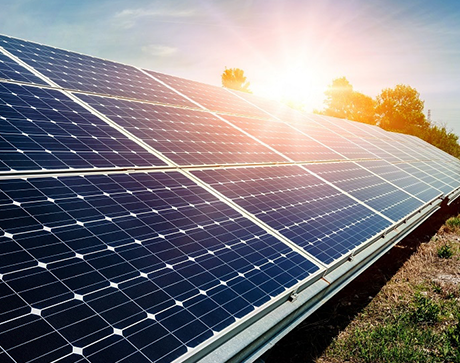BETTER TOUCH BETTER BUSINESS
Contact Sales at Litel Technology

What is solar panel?
A solar panel is a device that converts solar radiation directly or indirectly into electrical energy through the photoelectric effect or photochemical effect by absorbing sunlight. It is so large that its general use has certain limitations.
Compared with ordinary batteries and rechargeable batteries, solar cells are more energy-saving and environmentally friendly green products.
At present, crystalline silicon materials (including polycrystalline silicon and monocrystalline silicon) are the most important photovoltaic materials, with a market share of more than 90%, and will still be the mainstream material for solar cells for a long period of time in the future. The production technology of polysilicon materials has long been in the hands of 10 factories of 7 companies in 3 countries including the United States, Japan, and Germany, resulting in technology blockade and market monopoly. The demand for polysilicon mainly comes from semiconductors and solar cells.
The photoelectric conversion efficiency of monocrystalline silicon solar cells is about 18%, and the highest is 24%, which is the highest photoelectric conversion efficiency of all types of solar cells, but the production cost is so high that it cannot be widely used. Since monocrystalline silicon is generally encapsulated with tempered glass and waterproof resin, it is durable and has a service life of up to 25 years.
The production process of polycrystalline silicon solar cells is similar to that of monocrystalline silicon solar cells, but the photoelectric conversion efficiency of polycrystalline silicon solar cells is much lower, and the photoelectric conversion efficiency is about 16%. In terms of production cost, it is cheaper than monocrystalline silicon solar cells, the material is simple to manufacture, power consumption is saved, and the total production cost is lower, so it has been greatly developed. In addition, the service life of polycrystalline silicon solar cells is also shorter than that of monocrystalline silicon solar cells. In terms of cost performance, monocrystalline silicon solar cells are slightly better.
1. Low-watt solar panels can be measured, but high-power solar panels cannot be measured only with a multimeter.
The output voltage value measured when the photovoltaic cell is placed under the light source of 100mW/cm2 and the output of the photovoltaic cell is open-circuited. Use the DC voltage range of the multimeter, the red test lead is connected to the positive pole of the battery board, and the black test lead is connected to the negative pole of the battery board for measurement.
Short-circuit current: refers to the current flowing through the photovoltaic cell when the output is short-circuited under the irradiation of a standard light source. The general method of measuring short-circuit current is to connect an ammeter with an internal resistance of less than 1 ohm to both ends of the photovoltaic cell for measurement.
Use the DC current gear of the multimeter, the red test lead is connected to the positive electrode of the solar panel, and the black test lead is connected to the negative electrode of the Solar panel.
Calculation:
maximum output power (Pm): maximum output working voltage (Vpm) × maximum output working current (Ipm).
Photovoltaic panels have 18V, 36V, etc. 12V system street lights can use 18V solar panels in parallel, 24V system street lights can use 36V solar panels, or 18V solar panels can be connected in series.
At present, There are 100W, 250W, 300W∽345w (about 1m*2m) common, and the 470W solar panel is very large, the inverter controller in the photovoltaic system is very important, also mPPt is currently the best.
2. Solar panel currently on the market:
Monocrystalline silicon: 125mm*125mm, wattage: 2.5W-2.7W (W/mm)
Polysilicon: 156mm*156mm, Wattage: 3W-4W
Cell conversion efficiency = wattage/area
For example: 2.5W/(125mm*125mm*0.99) missing corner of single crystal
Study by example:
Watt conversion area: 2.5W/1000=0.00259 (W/m)
Area: 125mm*125mm * 0.99=0.01546 ㎡
Conversion efficiency: wattage/area=0.00259/0.01546=0.1675
That is, the conversion efficiency of 2.5 watt monocrystalline cells can reach 16.8%.
3. Solar panel voltage 12V (36 pieces) or 24V (72 pieces)
Study by example:
How to make a 120W/24V Solar panel.
120W/72=1.67
1.67*2=3.3W
Conversely, it can be deduced that it can be cut by 1/2 of the 3.3W polycrystalline cell: 3.3*1/2*72=119W (the size of the solar cell can be a little error, there is a 5% float)
4. The working voltage of the solar panel
Voltage of a single cell: 0.48V~0.5V
The normal 12V system battery board operating voltage is 17.5V, and the 24V system battery board operating voltage is about 35V; (0.48V~0.5V )*36=(17.28~18) (0.48V~0.5V )*72=(34.5~36)
5. Calculation of solar panel specifications:
Arrangement of normal panels: 4*9 or 6*12
Study by example:
90W/12V monocrystalline solar panel area calculation:
90W can be 2.5W*36; according to 4*9 arrangement, a single 2.5 watt cell is 125*125mm.
The width is: 4*125=500+45 (the gap between the cells and the frame length)=545mm
The length is: 9 *125=1125+80 (gap between cells, junction box, and frame length)=1205mm
Result: So the size of the 90W monocrystalline solar panel is 545*1205mm.
120W/24V polycrystalline solar panel area calculation:
120W/24V can be 3.3W (1/2 cut)*72;
Arranged according to 6*12, a single cell is 156*156mm
The width is: 6*156=936+45 (the gap between the cells and the length of the frame)=992mm
The length is: 12*156/2+80 (the gap between the cells, the junction box, and the length of the frame)=1020mm
Result: So the size of the 120W polycrystalline solar panel is 992*1020mm.
Copyright © 2025 Guangzhou Litel Technology Co.,Ltd. | All Rights Reserved
We are here to help you! If you close the chatbox, you will automatically receive a response from us via email. Please be sure to leave your contact details so that we can better assist